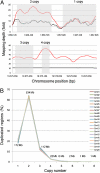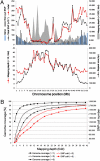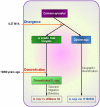Whole-genome sequencing and intensive analysis of the undomesticated soybean (Glycine soja Sieb. and Zucc.) genome
- PMID: 21131573
- PMCID: PMC3009785
- DOI: 10.1073/pnas.1009526107
Whole-genome sequencing and intensive analysis of the undomesticated soybean (Glycine soja Sieb. and Zucc.) genome
Abstract
The genome of soybean (Glycine max), a commercially important crop, has recently been sequenced and is one of six crop species to have been sequenced. Here we report the genome sequence of G. soja, the undomesticated ancestor of G. max (in particular, G. soja var. IT182932). The 48.8-Gb Illumina Genome Analyzer (Illumina-GA) short DNA reads were aligned to the G. max reference genome and a consensus was determined for G. soja. This consensus sequence spanned 915.4 Mb, representing a coverage of 97.65% of the G. max published genome sequence and an average mapping depth of 43-fold. The nucleotide sequence of the G. soja genome, which contains 2.5 Mb of substituted bases and 406 kb of small insertions/deletions relative to G. max, is ∼0.31% different from that of G. max. In addition to the mapped 915.4-Mb consensus sequence, 32.4 Mb of large deletions and 8.3 Mb of novel sequence contigs in the G. soja genome were also detected. Nucleotide variants of G. soja versus G. max confirmed by Roche Genome Sequencer FLX sequencing showed a 99.99% concordance in single-nucleotide polymorphism and a 98.82% agreement in insertion/deletion calls on Illumina-GA reads. Data presented in this study suggest that the G. soja/G. max complex may be at least 0.27 million y old, appearing before the relatively recent event of domestication (6,000∼9,000 y ago). This suggests that soybean domestication is complicated and that more in-depth study of population genetics is needed. In any case, genome comparison of domesticated and undomesticated forms of soybean can facilitate its improvement.
Conflict of interest statement
The authors declare no conflict of interest.
Figures




Comment in
-
Into the wild: The soybean genome meets its undomesticated relative.Proc Natl Acad Sci U S A. 2010 Dec 21;107(51):21947-8. doi: 10.1073/pnas.1016809108. Epub 2010 Dec 13. Proc Natl Acad Sci U S A. 2010. PMID: 21149697 Free PMC article. No abstract available.
Similar articles
-
Integration of the Draft Sequence and Physical Map as a Framework for Genomic Research in Soybean (Glycine max (L.) Merr.) and Wild Soybean (Glycine soja Sieb. and Zucc.).G3 (Bethesda). 2012 Mar;2(3):321-9. doi: 10.1534/g3.111.001834. Epub 2012 Mar 1. G3 (Bethesda). 2012. PMID: 22413085 Free PMC article.
-
Comparative analysis of complete plastid genomes from wild soybean (Glycine soja) and nine other Glycine species.PLoS One. 2017 Aug 1;12(8):e0182281. doi: 10.1371/journal.pone.0182281. eCollection 2017. PLoS One. 2017. PMID: 28763486 Free PMC article.
-
Construction and comparison of three reference-quality genome assemblies for soybean.Plant J. 2019 Dec;100(5):1066-1082. doi: 10.1111/tpj.14500. Epub 2019 Oct 28. Plant J. 2019. PMID: 31433882
-
The Untapped Genetic Reservoir: The Past, Current, and Future Applications of the Wild Soybean (Glycine soja).Front Plant Sci. 2018 Jul 9;9:949. doi: 10.3389/fpls.2018.00949. eCollection 2018. Front Plant Sci. 2018. PMID: 30038633 Free PMC article. Review.
-
The wild side of a major crop: soybean's perennial cousins from Down Under.Am J Bot. 2014 Oct;101(10):1651-65. doi: 10.3732/ajb.1400121. Epub 2014 Sep 8. Am J Bot. 2014. PMID: 25326613 Review.
Cited by
-
Dynamic genetic features of chromosomes revealed by comparison of soybean genetic and sequence-based physical maps.Theor Appl Genet. 2013 Apr;126(4):1103-19. doi: 10.1007/s00122-012-2039-8. Epub 2013 Jan 10. Theor Appl Genet. 2013. PMID: 23306355
-
DaizuBase, an integrated soybean genome database including BAC-based physical maps.Breed Sci. 2012 Jan;61(5):661-4. doi: 10.1270/jsbbs.61.661. Epub 2012 Feb 4. Breed Sci. 2012. PMID: 23136506 Free PMC article.
-
Multi-Omics Techniques for Soybean Molecular Breeding.Int J Mol Sci. 2022 Apr 30;23(9):4994. doi: 10.3390/ijms23094994. Int J Mol Sci. 2022. PMID: 35563386 Free PMC article. Review.
-
Archaeological soybean (Glycine max) in East Asia: does size matter?PLoS One. 2011;6(11):e26720. doi: 10.1371/journal.pone.0026720. Epub 2011 Nov 4. PLoS One. 2011. PMID: 22073186 Free PMC article.
-
De novo assembly of soybean wild relatives for pan-genome analysis of diversity and agronomic traits.Nat Biotechnol. 2014 Oct;32(10):1045-52. doi: 10.1038/nbt.2979. Epub 2014 Sep 14. Nat Biotechnol. 2014. PMID: 25218520
References
-
- Carter TE, Jr., Nelson R, Sneller CH, Cui Z. Genetic diversity in soybean. In: Boerma HR, Specht JE, editors. Soybeans: Improvement, Production and Uses. Madison, WI: Am Soc Agron; 2004. pp. 303–416.
-
- Zhang WK, et al. QTL mapping of ten agronomic traits on the soybean (Glycine max L. Merr.) genetic map and their association with EST markers. Theor Appl Genet. 2004;108:1131–1139. - PubMed
-
- Kang S-T, et al. Population-specific QTLs and their different epistatic interactions for pod dehiscence in soybean (Glycine max (L.) Merr.) Euphytica. 2009;166:15–24.
-
- Sasaki T, Antonio BA. Plant genomics: Sorghum in sequence. Nature. 2009;457:547–548. - PubMed
Publication types
MeSH terms
LinkOut - more resources
Full Text Sources
Other Literature Sources
Miscellaneous

